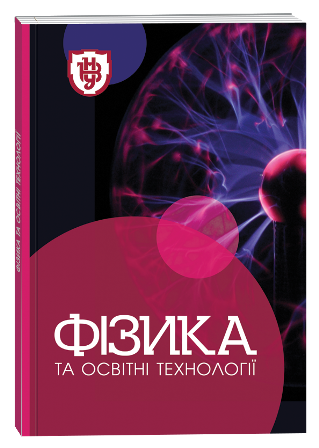AB-INITIO STUDIES OF THE ELECTRONIC STRUCTURE OF THE TlSbSe2 CRYSTAL
DOI:
https://doi.org/10.32782/pet-2024-1-6Keywords:
semiconductor, density functional theory, chalcogenide, band structure, dielectric functionAbstract
The paper investigates the electronic structure of the TlSbSe2 crystal in the monoclinic phase from the first principles. Studies of the structure of electronic levels in this crystal have not been carried out before, so such studies are important and relevant in view of the possibility of its potential practical application. The CASTEP program, based on the Kohn-Sham theory, was used to model the properties of the crystal. As an approximation, the generalized gradient approximation with Perdue-Burke-Ernzerhoff parameterization was used to describe the exchange-correlation interaction. The plane wave energy was limited to 450 eV. In order to obtain the structure in the ground state, the geometric optimization of the crystal lattice was previously carried out using the Broyden-Fletcher-Goldfarb-Shanno method. For the first time, the geometric optimization of the crystal structure was carried out and it was found that the best agreement with the experimental results is given by the lattice parameter a (deviation δa = 0.6%). The maximum deviation of the optimized lattice parameter from the experimental value obtained for parameter c is 4.8%. The analysis of the crystal lattice also shows an increase in the β angle by 30' when the GGA functional is used. The band-energy structure of the TlSbSe2 crystal in the structure of monoclinic symmetry was calculated for the first time. Its analysis shows that the conduction band and the top of the valence band of the crystal are formed by wide bands. The bottom of the conduction band is located on the segment Г → Y of the first Brillouin zone. The top of the valence band is located at point Z, forming a forbidden band of a nondirect type. The calculated value of Eg is 0.99 eV. It was found that the conduction band is formed by s- and p-states of Tl, Sb, and Se atoms, and the top of the valence band is formed by s-states of antimony and p-states of selenium. The most intense peak in the DOS/PDOS spectra corresponds to localized d-states of Tl atoms.
References
Deger D., Ulutas K., Yildirim S., Kalkan N. Relaxation spectrum of the TlSbSe2 thin films, Physica B: Condensed Matter. 2009. 404. P. 5231–5233.
Wacker K., Salk M., Decker-Schultheiss G., Keller E. Die Kristallstruktur der geordneten Phase der Verbindung TlSbSe2, Zeitschrift für anorganische und allgemeine Chemie. 1991. 606. P. 51–58.
Syrbu N. N., Krasovsky V. T., Grincheshen I. N. Optical Phonons and Chemical Bonding in TlSbS2, TlSbSe2, and Tl3SbS3 Crystals, Crystal Research and Technology. 1993. 28. P. 371–380.
Gervais F. Infrared and Millimeter Waves, 8th ed., Academic Press, New York, P. 1983.
Chrissafis K., Ozer M., Vinga E., Polychroniadis E., Chatzistavrou X., Paraskevopoulos K. M. Characterization and phase transformation study of TlSbSe2 crystals, J Therm Anal Calorim. 2006. 86. P. 839–843.
Ren J., Whangbo M. H., Bengel H., Cantow H. J., Magonov S. N. Interpretation of the scanning tunneling and atomic force microscopy images of layered compound TlSbSe2 by electron density calculations, Chemistry of Materials. 1993. 5. P. 1018–1023.
Banys J., Grigas J., Valiukenas V., Wacker K. Microwave dielectric properties of TlSbSe2 crystals, Solid State Communications. 1992. 82. P. 633–636.
Hoang K., Mahanti S. Atomic and electronic structures of thallium-based III-V-VI2 ternary chalcogenides: Ab initio calculations, Physical Review B. 2008. 77. P. 205107.
Clark S. J., Segall M. D., Pickard C. J., Hasnip P. J., Probert M. I. J., Refson K., Payne M. C. First principles methods using CASTEP, Zeitschrift Für Kristallographie – Crystalline Materials. 2005. 220. P. 567–570.
Lee J. G. Computational Materials Science: An Introduction.CRC Press. 2013. P. 269.
Perdew J. P., Zunger A. Self-interaction correction to density-functional approximations for many-electron systems, Phys. Rev. B. 1981. 23. P. 5048–5079.
Perdew J. P., Burke K. Ernzerhof M., Generalized Gradient Approximation Made Simple, Phys. Rev. Lett. 1996. 77. P. 3865–3868.
Vanderbilt D. Soft self-consistent pseudopotentials in a generalized eigenvalue formalism, Phys. Rev. B. 1990. 41. P. 7892–7895.
Pfrommer B. G., Côté M., Louie S. G., Cohen M. L. Relaxation of Crystals with the Quasi-Newton Method, Journal of Computational Physics. 1997. 131. P. 233–240.
Chrunik M., Majchrowski A., Ozga K., Rudysh M. Ya., Kityk I. V., Fedorchuk A. O., Stadnyk V. Yo., Piasecki M. Significant photoinduced increment of reflectivity coefficient in LiNa5Mo9O30, Current Applied Physics. 2017. 17. P. 1100–1107.
Chen J. – A., Piasecki M., Yang C. – C., Rudysh M., Liu W. – R. Synthesis, luminescent properties and ab initio study of yellow-emitting Sr8MgGa(PO4)7:Eu2+phosphors for white light-emitting diodes, Journal of Luminescence. 2021. 235. P. 117982.
Rudysh M. Y., Myronchuk G. L., Fedorchuk A. O., Marchuk O. V., Kordan V. M., Kohan O. P., Myronchuk D. B., Smitiukh O. V. Electronic structure and optical properties of the Ag3SbS3 crystal: experimental and DFT studies, Phys. Chem. Chem. Phys. 2023. 25. P. 22900–22912.








